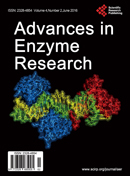Research

Cancer
Advances in Enzyme Research
Alternative Impact Factor
With respect to all articles from this journal for the respective year:
A = total cites in 2022 = 149
B = 2022 cites to articles published in 2020 - 2021 = 10 (this is a subset of A)
C = number of articles published in 2020 - 2021 = 13
2-GJIF for 2022 = D = B/C = 10/13 = 0.77 (TR algorithm, Google citations, data July 2024)
Please see also the List of Citations for AER. An impact factors for e.g. 2022 can only be published once this year is over (e.g. in 2023). At Clarivate Analytics (formerly Thomson Reuters) this is done when all 2022 publications have been processed. Once published, the JCR®JIF for a given year is fixed. In contrast, a GJIF has never a fixed value. Depending on individual activities on the Internet (self-archiving and Green Open Access), some articles published Closed Access in one year may appear online only months or even years later. This has an influence on Google Scholar's citation count and makes it necessary to state the 2-GJIF for a given year always with the date the data was retrieved from Google Scholar. SCIRP may provide updates of the 2-GJIF during the year. E = 2022 self-citations to articles published in 2020 - 2021 = 0 (this is a subset of B)
Self-Cited Rate = E/B = 0/10 = 0 % (definition Rousseau 1999, data July 2024) Journal self-citations are citations to articles in the same journal. A Self-Cited Rate below 20 % is considered acceptable. A higher Self-Cited Rate than this could be explained by a journal's novel or highly specific topic, but could also reveal a journal with excessive self-citations. Please interpret the 2-GJIF with caution:
• Due to differences in the underlying database, the value calculated here for the 2-GJIF can not be compared with a JCR®2-JIF.
• Do not compare journals from different subject fields based on their JIF. Journals in fundamental subject fields tend to have higher impact factors than journals in specialized or applied subject fields.
• Journal metrics should not be used to assess individual authors. Please refer instead to our article metrics provided for each paper: Number of citations from Google Scholar and number of citations from CrossRef. Statistics, Productivity, and Impact
Year in which journal started publishing = Y_start = 2013
Number of full years journal is publishing = Y = 10
Number of articles published since journal start = P_total = 91
Number of articles published in 2022 = P_2022 = 6
Total number of citations since journal start = C_total = 1226
Number of citations in 2022 = C_2022 = A = 149
Average number of citations per year = C_total/Y = 1226/10 = 122.6
Average number of citations per paper = C_total/P_total = 1226/91 = 13.5
with data from July 2024. For any further questions please feel free to contact [email protected].

Leading academic platform that is exclusive
with medical publications and research
Health in Kurdistan, Iraq and the world
About
Sections